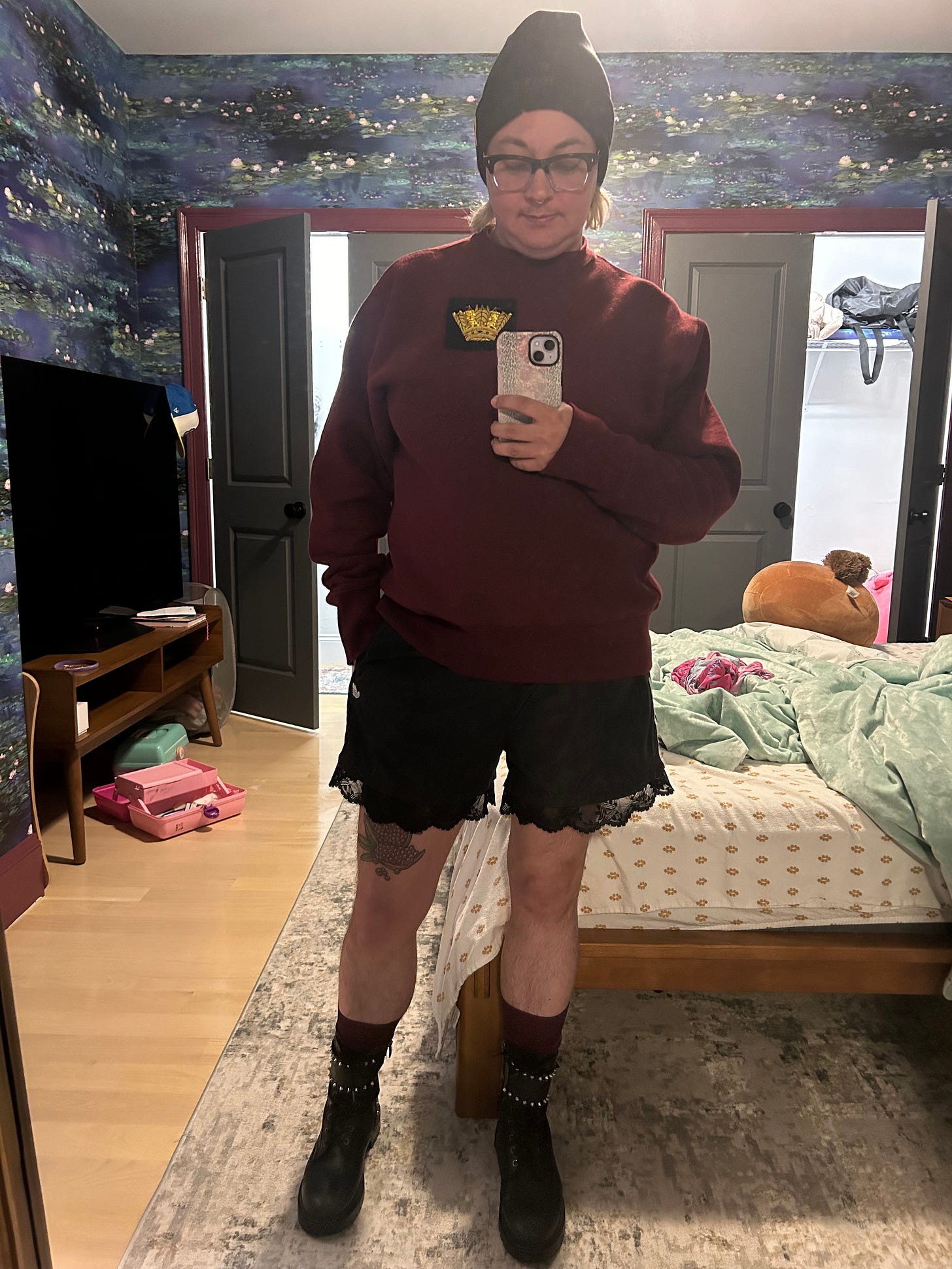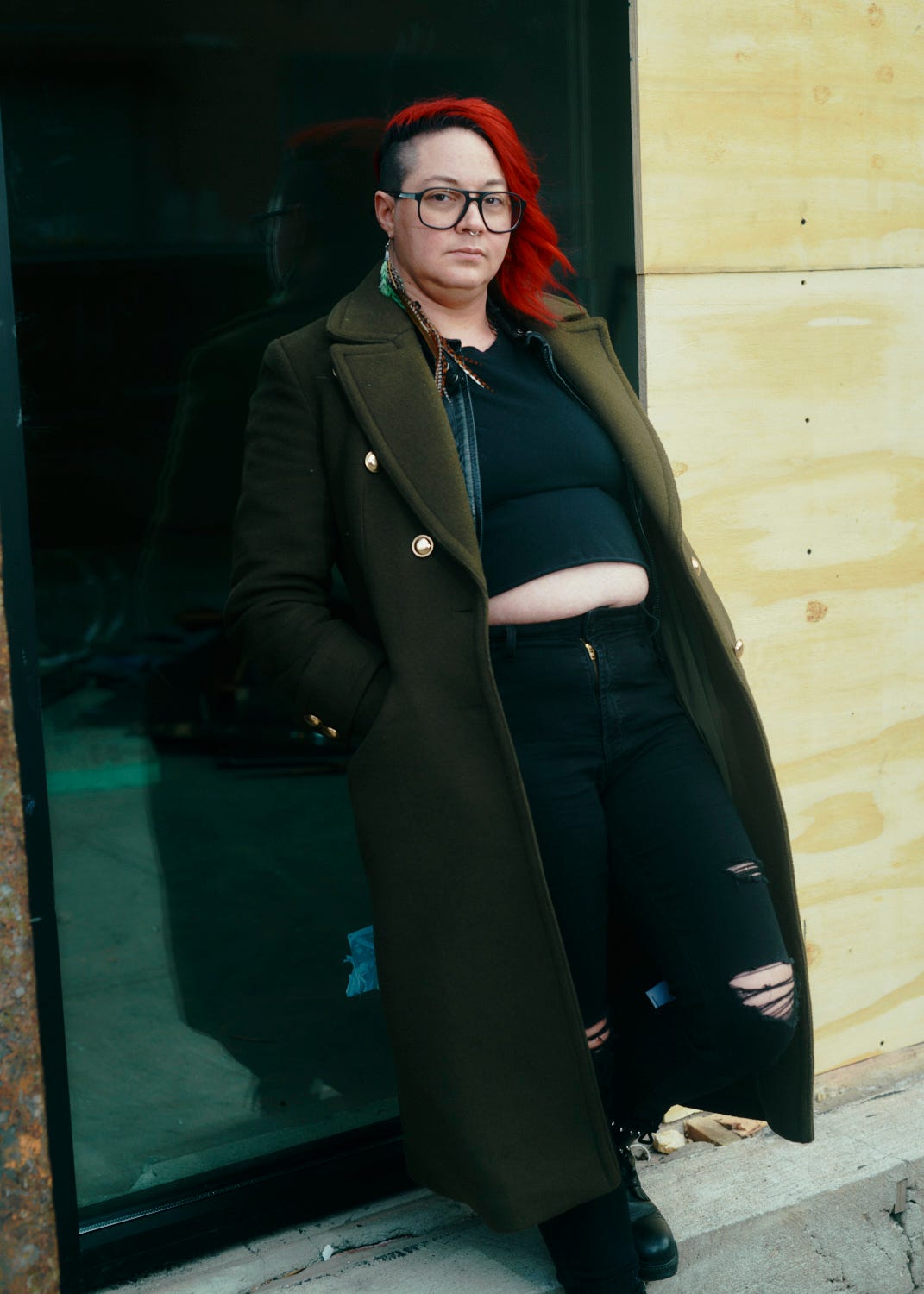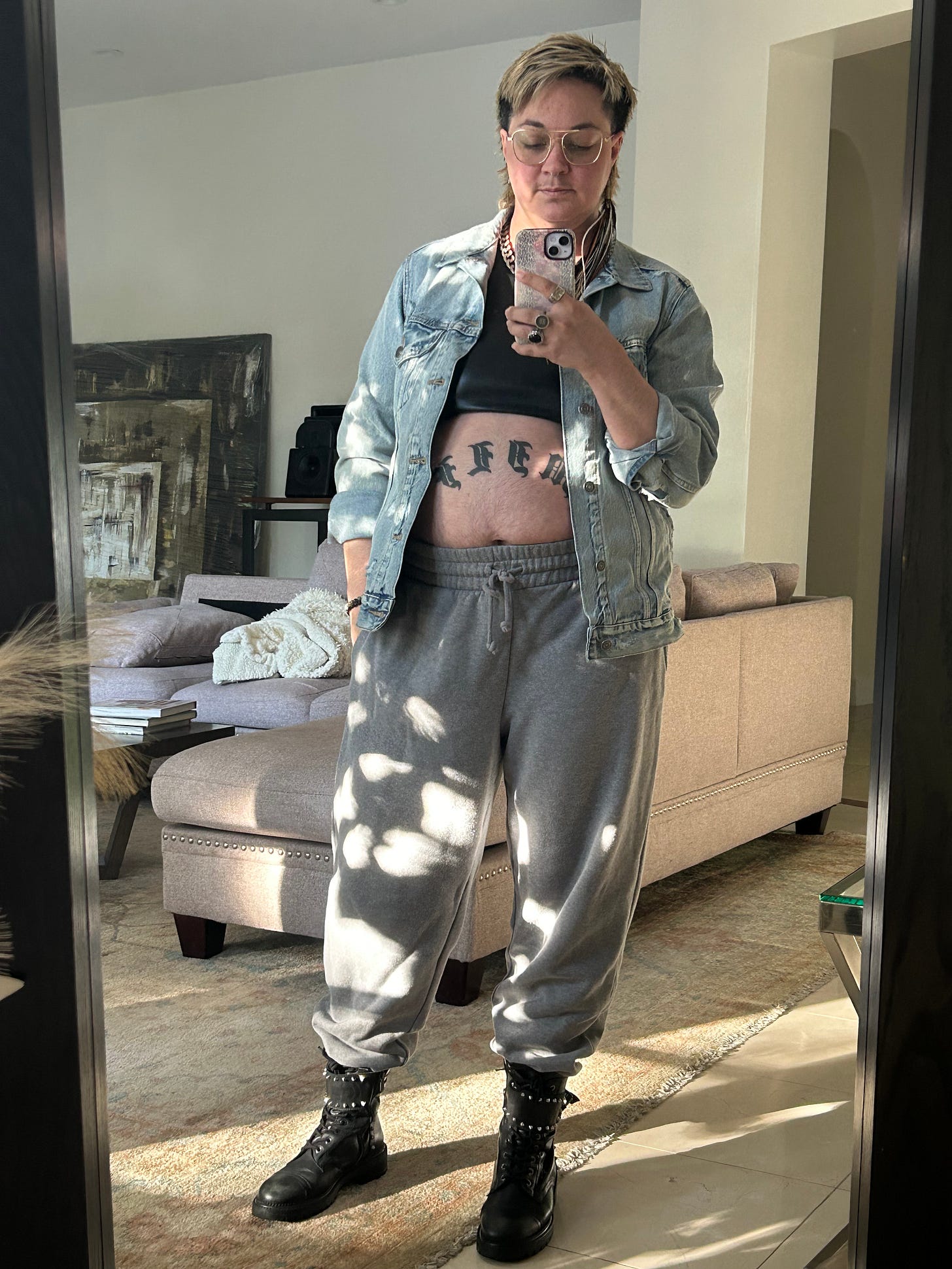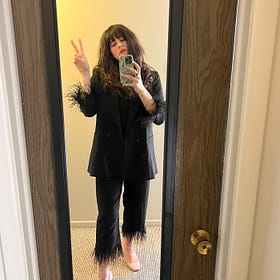A couple of months ago, I asked you all to recommend writers on Substack whose style you’d love to know more about.
volunteered themselves, and I am so glad they did. This style story has so many elements that I think all of you will really relate to, from needing to look "hot” to being in the middle of a transitional phase and the discomfort that comes with that. Bonus: I have never been interested in sports, but reading Frankie’s Substack Out of Your League is really compelling. They break down sports and gender in sports through the lens of white supremacism, patriarchy, and capitalism, which is what I’m always trying to do here with style. I'm really excited for you to read this one.Q: Introduce yourself, your pronouns, your work, and how you spend your time.
My name is Frankie de la Cretaz (they/them) and I am an independent journalist whose work sits at the intersection of sports, gender, and culture. I am the co-author of Hail Mary: The Rise and Fall of the National Women’s Football League (think: historical “women playing a traditionally masculine sport” ala A League of Their Own meets “the men thought it was a gimmick but the women made it real” ala GLOW). I also have a Substack called Out of Your League, which is full of my queer sports and pop culture musings.
Q: What was your style like when you were a child?
My style wasn’t distinct in any real way. I mostly stuck to current trends but I wasn’t trendy, if that makes sense. I graduated high school in 2003, if that gives you a sense of the kind of clothing that would have been in fashion at the time. I wasn’t overly feminine, so I didn’t wear a lot of dresses, but I was definitely concerned with looking “hot” in a way that I thought would translate to boys, but also looking “cool” in a way that wouldn’t alienate me socially.

Q: Growing up, what messages were you given about what you should or shouldn’t wear (and from whom or where do you think those messages came)?
I grew up in a house that valued “prettiness” for girls, above all else. Well, that and thinness. Whenever I wore something that was more explicitly feminine or that fit into conventional style standards, I got a lot of praise and was told how beautiful I looked. I wasn’t necessarily told outright not to wear things that were more adventurous or unconventional, but there was disapproval when I did, whether it was in the form of suggesting I wear something else or telling me I looked better in a different style.
I also was obsessed with celebrities, particularly female ones. I see it now as very “do I want to be her or do her or both” but as a teen I didn’t really have language for or awareness of my queerness. I subscribed to Teen Vogue and Teen People and YM and all those magazines and read them cover-to-cover every month. My room was wallpapered with the covers of those magazines. Britney Spears and Jennifer Love Hewitt were postered on my walls and I definitely tried to emulate them as much as I could.
Q: How has your style evolved since you were younger and what phases have you gone through with your style (i.e. high school grunge phase, early working days business casual phase, etc)?
I didn’t really find a personal style until college when I came out as queer. I really embraced the “quirky girl” aesthetic, very manic pixie dream girl-esque. The sort of high femme, queer femininity embodied by over-the-top dresses—tulle, sequins, layers of jewelry, sky high heels. Candy-colored hair has also been a staple of my expression for a long time.
Q: How have external pressures to conform to the ideal standard of beauty and the thought of how others view you affected your style?
My biggest challenges came from my mother. Anytime I ventured away from traditional, conventional beauty or femininity it was always very clear she disapproved. When I moved back home after college I had to stop dyeing my hair bright colors and take the hoop piercing out of my nose because I was living with her and she told me I couldn’t live there if I had them. Even well into adulthood, she was very concerned with how my appearance would reflect on her. When I got married, she wanted me to dye my hair brown for the wedding even though it had been bright red for many years at that point, because she was worried about what people would think about her.

I also really struggled with the idea of not being “hot.” Even in my quirkier iterations of femininity, I had a hard time letting go of the male gaze because I was taught that my power in the world came from being able to attract men. My worth was also very attached to whether or not men desired me. Even after I stopped dating cis men, the idea that I might lose access to the social power I had over men was really difficult for me to fully divest from or give up.
new series: style stories
Trying to find your style in the shouting noise of influencers, fashion “experts”, and retailers can be hard. What is what you like and what is what you’ve been told to like? What is what you like and what is what you’ve been conditioned to think you
Q: How have your sense of style and shopping habits shifted along with changes in your body?
During the pandemic I came out as non-binary and started taking testosterone. At the time I was quite comfortable in my style and aesthetic of “queer hard femme” but I’ve really struggled to adapt that aesthetic to my changing body. There’s a disconnect from how I want to look and how I do look, and not just in terms of physical changes that hormones will provide. I spent a lifetime learning how to wear women’s clothing of a certain style. I’ve always been straight-sized so I could buy things without trying them on and know whether they would work for what I was trying to accomplish.
Now I shop from the men’s and women’s sections but I often get stuck between women’s clothes that I worry make me look too much like, well, a woman, or men’s clothing that makes me look more butch than I want to. I am still femme, but femme like a boy is femme rather than how a girl is femme, if that makes sense? Men’s clothing is also cut very differently from women’s, not just in terms of having no room for my hips or thighs or chest, but also just generally. I have no idea what size I am in men’s clothing or what cuts fit my body best and going to a store and trying those things on is very time intensive and emotionally laborious, as the gap between what I want to look like in my head and what I look like in reality can sometimes feel quite wide.

However, I will say that there are a few overarching aesthetic choices that have remained constant across genders for me: I love layering items of clothing (I used to joke that undressing me was like unwrapping an intricately wrapped gift), I love wearing excessive amounts of statement jewelry, and I really like pattern and/or texture mixing (animal print and stripes, or something like a mesh top with a leather jacket and denim bottoms).
style story: jessica defino
When I joined Substack a little less than a year ago, one of the first people I was starstruck by was Jessica DeFino. Her writing and takedown of the beauty industry is so powerful and has clearly made a difference in many of her readers’ lives. I felt like she was doing with the beauty industry and beauty standards what I wanted to do with the fashion industry and the “rules” we’ve been taught to follow when getting dressed (although on a much larger and more impactful platform). When I was conceptualizing this series, she was one of the first people I thought of because I selfishly wanted to know how her ideas on beauty have translated to her wardrobe. You’ll love hearing her take on clothes, and incidentally, not sure how we’ve gone so long without it, but I believe this is the first official mention of “What Not to Wear”, which I know we all have big feelings about. Enjoy!
Q: What barriers do you encounter in trying to express your style? Are there any situations or spaces you feel your style prohibits you from accessing or gives you better access to?
For me the biggest barrier to expressing my style the way I want to has been money. Between my body changing during transition, my understanding of how to express my gender through clothing, and gaining a decent amount of weight over the last few years, I have needed to buy a lot of clothing that I just can’t always afford. It’s expensive to purchase a whole new wardrobe every six months. I’m currently in that place—most of my clothing doesn’t fit quite right so it doesn’t feel good on my body but I am not in the financial place to be able to afford to buy a bunch of new stuff right now.

Q: Do you have any style icons? Who are they?
I describe my gender as somewhere between Cara Maria Sorbello from The Challenge and David Rose from Schitt’s Creek. I love the aesthetic of Adam Lambert when he is performing onstage with Queen, or even the character of Carlos from Disney’s Descendents franchise.
Q: How would you define your current relationship to clothes and style?
Evolving but definitely a bit strained. I have always loved clothing and used it as armor in a way that felt really good and made me feel powerful. Trying to figure out how to dress the new body I have and the gender I want to express has been really frustrating and at times quite demoralizing. Like… I used to know how to dress in ways that made me feel good and I no longer really know how to do that and that’s really hard for me.
Q: What makes your style authentic to who you are today?
I love walking in a room full of cishet people and realizing that they’re not quite sure how to gender me. I love the fact that everything about what I wear is a rejection of the beauty standards that were put on me as a child and teenager.
Q: Do you wear anything that’s conventionally considered unflattering?
I have a belly and that belly now has hair on it because of testosterone and I love wearing crop tops. In fact, to celebrate one year on T, I got the word “MILF” tattooed across my belly and I love it so much.
style story: virgie tovar
I was trying to remember when I first became aware of Virgie Tovar and I really can't. She was definitely one of the first people I came across when I was discovering the worlds of body acceptance and fat positivity. Her writing is brilliant, but I also remember being charmed by her personal style. I was so excited and grateful when she agreed to do a style story. When I read her email with her responses, I actually exclaimed (some sort of joyful noise, not a word or anything) because it was one of the most positive and affirming and delightful things I've ever read. I know you’re going to love it.
Q: Just for fun, what are 3 things in your wardrobe you’d recommend to others (could be a specific item from a specific brand or just a type of item you find useful)?
Just one: a leather (or vegan leather) jacket is the most versatile item in my closet—I can dress it up or down and I feel like everyone looks cool in one.
Frankie, thank you so much for sharing your style story. I know many pieces of this will resonate with so many readers.
P.S. the unflattering X burnt toast style challenge is still going strong! We are on week two, which is honoring your comfort. Feel free to join us! Share your reflections and see links to the items in my outfits on Friday.
Paid subscribers, read on for some of my jacket suggestions.









